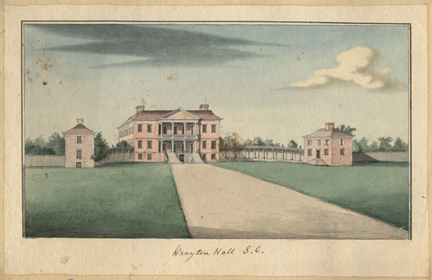Voted the Best Place to See by Condé Nast Traveler.

Read below for an interesting article on the ongoing mystery of the Drayton Hall colonnade by Post and Courier writer Robert Behre……
Drayton’s colonnade still poses much mystery
By Robert Behre
Monday, August 22, 2011
Four years ago, an old watercolor of Drayton Hall mysteriously surfaced, showing a prominent feature that had been lost to history. The feature — a colonnade that linked the main house with its two flanker buildings– had never been seen before by anyone with the National Trust for Historic Preservation.The image, which dated from 1765, only triggered more questions. Among the biggest was this: What was the colonnade’s architectural role? Was it built to provide shade and shelter to those walking between the main house and its support buildings or simply to provide a visual screen between the eastern and western sides of the property?
This summer, Drayton Hall’s archaeologist Sarah Stroud attempted to unearth some answers. A case of beer was riding on the outcome, but more about that later. In 2009, an archaeological dig found a prominent soil stain believed to be the colonnade, but only one wall was found, indicating the structure was more of a screen.

Watercolor by P.E. Du Simitiére (born Geneva, Switzerland 1737-1784) Drayton Hall S.C. © J. Lockard 2010 All rights reserved
Stroud thinks the colonnade served a more significant purpose. She thinks the columns and wall were separated by several feet and supported a roof that would have provided a covered walkway. So she mapped out a 10-foot by 15-foot plot on the northern side of the house that she hoped would contain new evidence of the wall.
As her dig winds up this week, she acknowledges that it didn’t. But her efforts weren’t in vain. The dig did uncover other evidence, such as traces of small post holes, more clay pipe stems than anywhere else on the property dug up so far, a tiny brass door pull, a glass perfume bottle stopper and a large square feature in the center that Stroud is still contemplating.
The colonnade is far from the only history that Stroud is trying to flesh out. Archaeology also can play an important role in interpreting Native Americans’ presence on the site, as well as the European settlers who occupied it for a few generations before the Drayton family bought it. But the colonnade was this summer’s focus, and Carter Hudgins, Drayton Hall’s director of preservation, had bet Stroud a case of beer that the colonnade was a screen, not a walkway. “Carter might be closer to his case of beer for the summer, but I’m not admitting defeat,” she says. “I think it’s still out there.”
The wall’s exact location and curvature is unknown — as are the materials from which it was built. Stroud says she might have struck out because she was digging in the wrong spot or because the earth there was disturbed to remove any traces of the colonnade, which is believed to have been removed during the Revolutionary War.
If Stroud ultimately loses the beer bet, she will gain a little job security as her hunt for answers goes on. “It means I’ll get to dig again,” she said.
Copyright © 1995 – 2011 Evening Post Publishing Co..